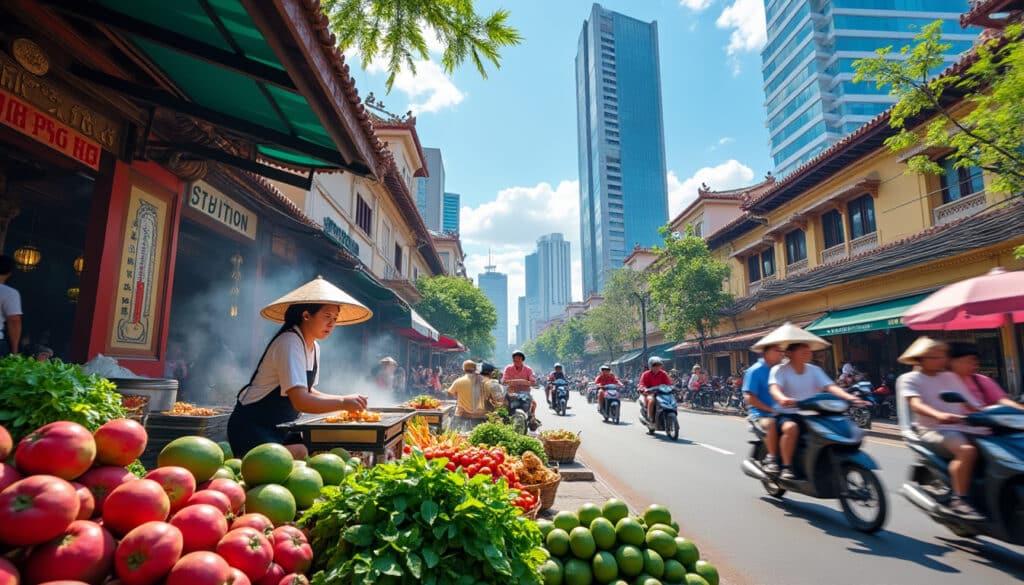The city of Hanoi, a bustling hub of culture and history, offers a distinctive climate that shapes its daily life. Nestled in the heart of Vietnam, Hanoi experiences a variety of weather conditions, from humid summers to mild, dry winters. This diverse climate not only influences the lifestyles of its residents but also significantly impacts tourism. For those planning to explore the vibrant street life or the serene pagodas of Hanoi, understanding its climate is crucial for an optimal experience. Whether you are captivated by the lush green landscapes after a monsoon or prefer the crisp air of winter, Hanoi’s weather presents a kaleidoscope of experiences year-round.
The Year-Round Climate of Hanoi
Hanoi’s climate falls under the Köppen climate classification as Cwa, indicating a humid subtropical weather pattern with dry winters. The city’s geographical position plays a crucial role in shaping this climate, resulting in a variety of weather patterns throughout the year. One of the most striking features of Hanoi’s climate is its significant fluctuation in temperatures, which range from a cool 14.4°C (57.9°F) during the winter months to a sultry 35.4°C (95.7°F) in the peak of summer.
The rainfall in Hanoi exhibits remarkable variations across the year. The wettest months are typically between May and September, with August taking the lead at 338mm of rainfall. In contrast, the driest month, December, experiences only about 37 mm of precipitation. This fluctuation in rainfall directly affects the city’s humidity levels, ranging from a lower limit of 69% in the cooler months to a peak of 89% during the humid months of April.
These climatic variations also influence the daylight and sunshine hours. The summer months, particularly June, witness the longest daylight, spanning up to 13.4 hours, perfect for sightseeing and enjoying Hanoi’s dynamic street food scene. Conversely, February experiences the shortest sunshine duration, typically around 1.5 hours daily, making it the ideal time for soaking in Hanoi’s historical and cultural indoor attractions.
Visitors planning a trip to Hanoi should consider these climatic aspects for the best experience. While some might enjoy the tropical humidity and vibrant green landscapes post-rain, others may find the cool, dry winters more appealing for outdoor adventures.

Understanding Seasonal Variations in Hanoi
Breaking down Hanoi’s climate by season unveils more nuanced patterns, impacting both residents and travelers. Each season brings unique characteristics and challenges.
- 🌸 Spring: February to April sees temperatures rising from 14.4°C (57.9°F) to 21.8°C (71.2°F). This season starts with minimal rainfall, gradually increasing as summer approaches.
- ☀️ Summer: May to August is marked by high temperatures soaring to 35.4°C (95.7°F), with humidity levels hovering between 71-74%. August experiences substantial rainfall, marking the peak of the monsoon.
- 🍂 Autumn: September to November witnesses cooler temperatures ranging between 24.2°C (75.6°F) and 29.6°C (85.3°F). Rainfall decreases significantly from the summer high.
- ❄️ Winter: December to February brings down the thermometer to around 14.4°C (57.9°F), making it the coolest season, with sunshine hours at their yearly low.
Monthly Breakdown: Hanoi’s Weather Calendar
To further understand the intricacies of Hanoi’s climate, one can examine the weather month by month. Here’s a detailed look at what each month typically offers.
| Month | Temperature (°C) | Rainfall (mm) | Humidity (%) | Daylight (hrs) |
|---|---|---|---|---|
| January | 15°C | 15mm | 69% | 10.8 |
| February | 17°C | 7mm | 69% | 11.5 |
| March | 20°C | 26mm | 74% | 12.0 |
| April | 23°C | 46mm | 74% | 12.5 |
| May | 27°C | 73mm | 74% | 13.0 |
| June | 29°C | 92mm | 74% | 13.4 |
| July | 33°C | 338mm | 80% | 13.3 |
| August | 32°C | 135mm | 80% | 12.7 |
| September | 30°C | 103mm | 75% | 12.2 |
| October | 27°C | 28mm | 74% | 11.6 |
| November | 24°C | 34mm | 72% | 11.0 |
| December | 21°C | 20mm | 71% | 10.9 |
This detailed monthly breakdown portrays a vivid picture of Hanoi’s weather, guiding travelers to plan their visit according to their climate preferences. Whether looking to escape the cold or chase sunshine, each month in Hanoi offers a unique climatic experience.
Adapting to Hanoi’s Weather: Practical Tips for Visitors
For those planning to dive into the cultural tapestry of Hanoi, preparation against its varied weather conditions can enhance the experience. Here are some practical tips to make the most of Hanoi’s ever-changing weather.
- 🧥 Dressing Right: Layering is key. Light, breathable fabrics for the humid summer, and warm layers for the cooler winter months ensure comfort.
- ☂️ Rain Protection: A portable umbrella or raincoat is essential during the monsoon months to stay dry and continue sightseeing.
- 🕶️ Sun Safety: During sunny months, sunglasses, hats, and sunscreen can protect against the harsh sun, especially for prolonged outdoor activities.
- 🏞️ Plan Your Day: Leveraging early mornings and late afternoons minimizes exposure to midday sun and heat, especially in the summer months.
- 🏨 Accommodation Strategies: Early bookings are advisable during peak tourist seasons where demand is high.
Taking these measures ensures that travelers can fully enjoy the bustling streets, ornate temples, and the tantalizing street food that Hanoi is famous for, regardless of the weather.
Hanoi’s Climate: An Impact on Lifestyle and Environment
The climate of Hanoi not only affects daily life and tourism but also plays a significant role in the broader context of environmental and societal dynamics.
Hanoi’s monsoon-driven rainfall significantly influences urban planning and infrastructure. Initiatives like EcoHanoi and Sustainable Hanoi have propelled efforts towards building resilient and green urban spaces. As weather patterns become more unpredictable due to climate change, these efforts entail integrating Smart Climate Solutions in city planning.
The correlation between weather and air quality in Hanoi cannot be ignored. During humid months, elevated levels of pollution and particulates due to stagnant air can exacerbate health issues. Efforts to bolster Hanoi Air Quality are increasingly pertinent, with green initiatives focusing on reducing emissions.
In the realm of lifestyle, weather conditions dictate cultural practices and events. Traditional festivals, outdoor markets, and lifestyle choices ebb and flow with the seasons, adding a dynamic rhythm to the daily life in Hanoi.
These elements highlight the harmonious yet complex relationship between Hanoi’s climate and its inhabitants, showcasing the ingenuity in adapting and thriving amidst environmental challenges.
By examining Hanoi’s climate through the lens of weather innovations and climate action, we gain insights into creating sustainable futures, not just for Hanoi but for similar cities globally.
Frequently Asked Questions (FAQ)
Here are some commonly asked questions to help you understand Hanoi’s climate better:
- When is the best time to visit Hanoi? 🌟
- What is the hottest month in Hanoi? 🔥
- How does the rainy season affect travel plans? 🌧️
- Is air pollution a problem in Hanoi? 🏭
- How can tourists prepare for the varying climate? 🧳

Hanoi, the vibrant capital city of Vietnam, not only captivates visitors with its rich cultural heritage and delectable street food but also with a unique climatic variation that sees the city shivering under cold weather conditions during certain months of…

Hanoi, known for its bustling streets and rich cultural tapestry, may not be the first place that comes to mind when thinking of snow. The capital of Vietnam is renowned for its vibrant street food, historical landmarks, and lively markets…

Flooding and natural risks in Hanoi
Flooding Challenges and Natural Risks in Hanoi The vibrant city of Hanoi, known for its unique blend of age-old traditions and rapid urban growth, is no stranger to water-related challenges. Nestled along the banks of the Red River, Hanoi experiences…

As the summer sun climbs higher in the sky, the bustling streets of Hanoi transform under the play of light and shadow, painting a vivid tableau of life in Vietnam’s dynamic capital. Known for its rich cultural heritage and vibrant…

Hanoi, the vibrant capital of Vietnam, is renowned for its rich history, tantalizing street food, and intriguing blend of traditional and modern cultures. However, one of the most defining yet challenging aspects of living or traveling in Hanoi is its…
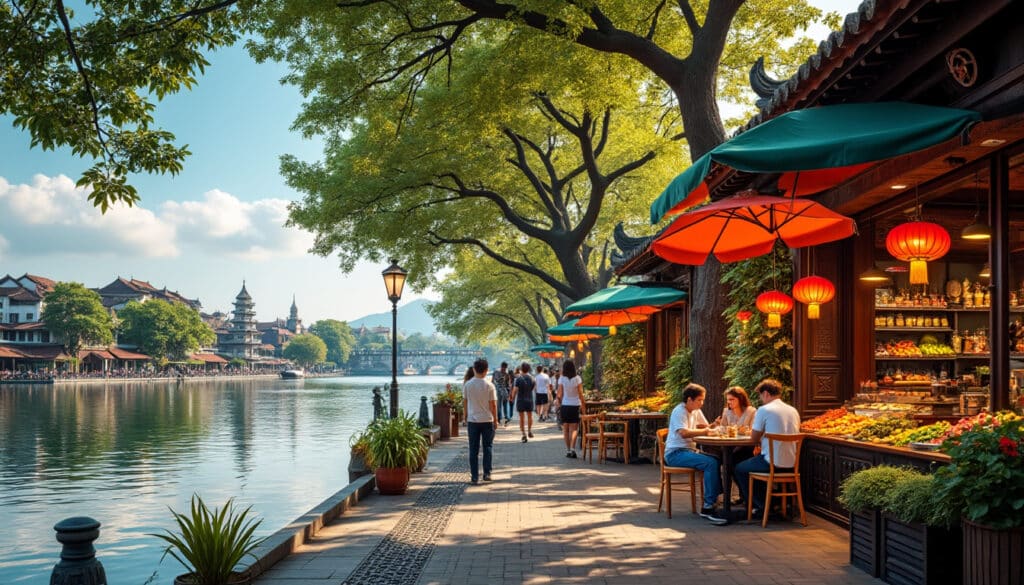
Is Hanoi warm throughout the year?
Hanoi, the vibrant capital of Vietnam, showcases a spectrum of weather conditions throughout the year, thanks to its unique geographic location. Encompassing the vivacious street life and the rich history of the city, understanding its climate is essential for both…
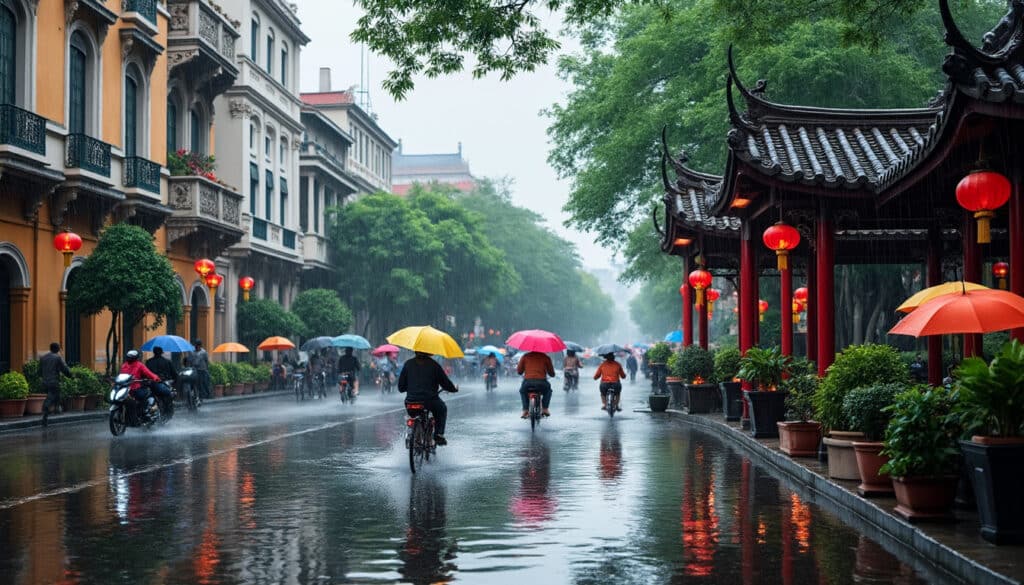
Rain and precipitation in Hanoi
Renowned for its vibrant streets, exquisite cuisine, and rich cultural history, Hanoi, the bustling capital of Vietnam, also presents weather patterns worth exploring. The city’s climate plays a crucial role in shaping its everyday life and the experience of both…
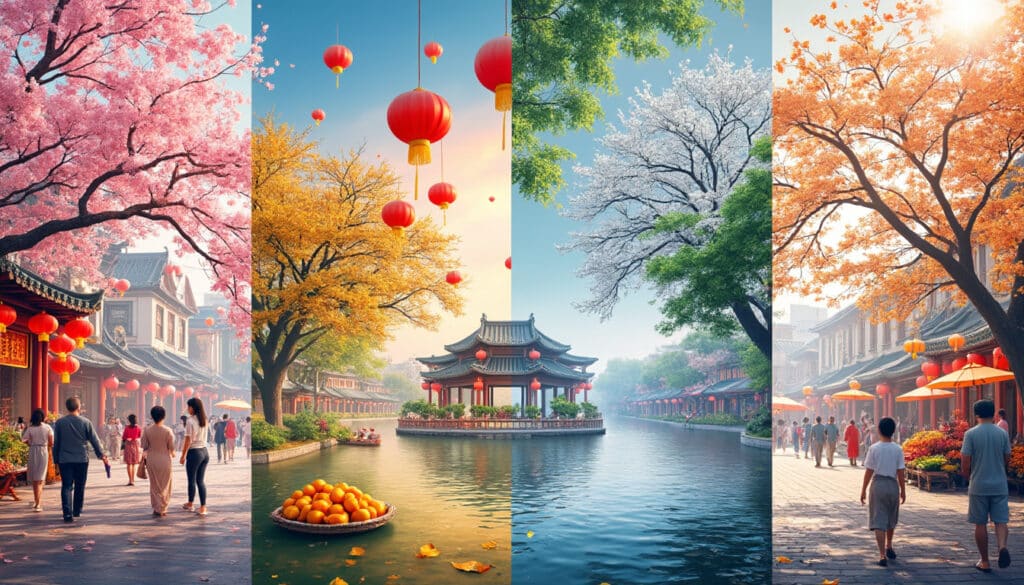
Hanoi, the captivating capital of Vietnam, is a place where the past seamlessly merges with the present. This city offers a unique blend of rich history, vibrant culture, modernity, and a distinct four-season climate, making it an exciting destination for…
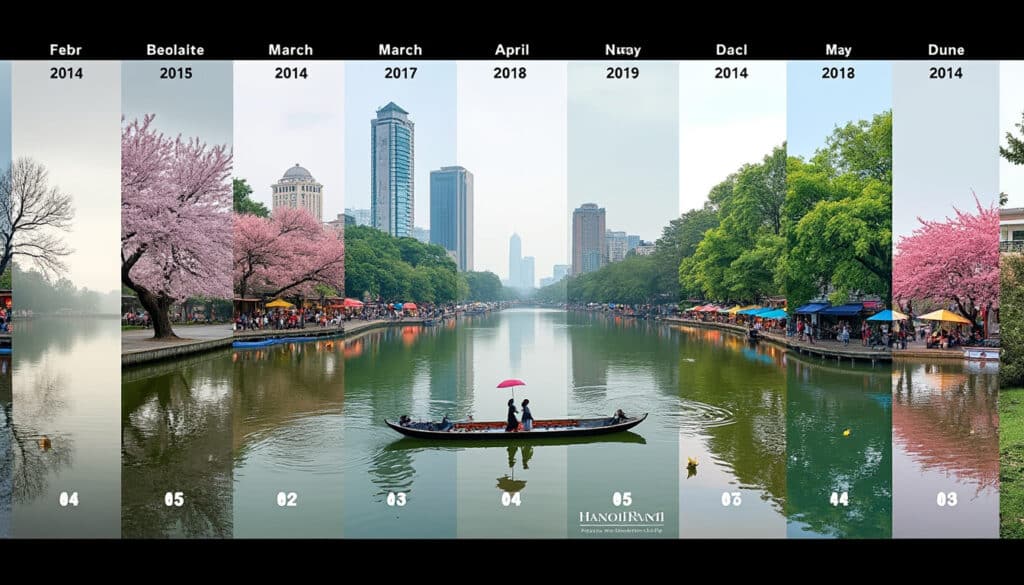
Hanoi, the vibrant capital city of Vietnam, is known for its unique weather patterns that change remarkably over the months. Whether it’s the cool breeze whispering through Hoan Kiem Lake in January or the heavy rains nurturing tropical greenery in…
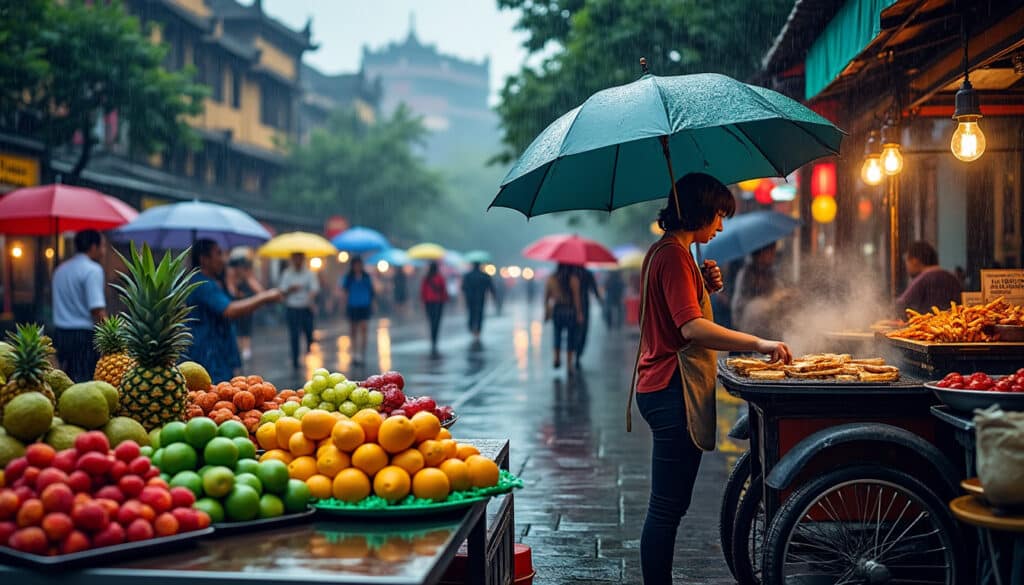
What is the weather like in Hanoi?
Hanoi is known for its vibrant street life, rich history, and diverse cuisine. Yet, understanding its weather patterns is crucial for enjoying all the city has to offer. Hanoi’s climate is characterized by hot, humid summers and cool, dry winters,…



